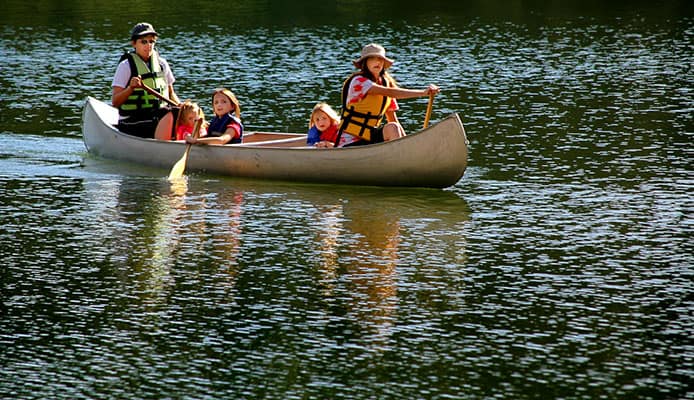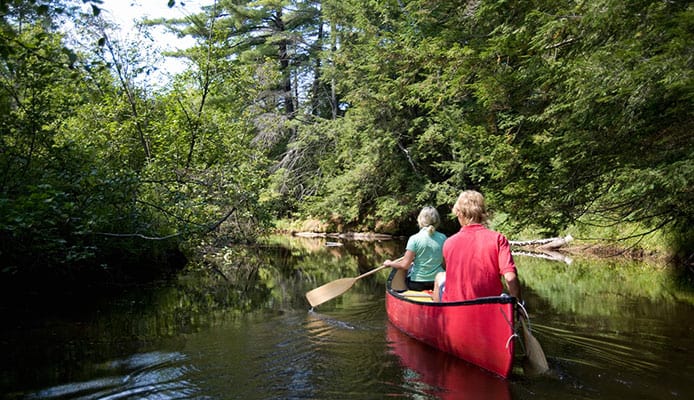
Fiberglass canoes are durable and it will probably be a couple of years until you see any signs of wear and tear. However long it takes though, eventually, your canoe will need some servicing and fiberglass canoe repair.
If you canoe regularly in swamps and creeks, you may come across logs floating on the water, rocks, or other obstructions. This makes the possibility of bumps or cracks all too real.
While there is always the option of buying a new one, often the better choice is repairing fiberglass canoes. You may also decide to have a professional do it for you but this will end up costing you more than if you were to repair the fiberglass canoe yourself.
With the right tools and a little know-how, you can have your fiberglass canoe looking brand new again.
Here is how to repair a fiberglass canoe.
The tools you will need
To fix your canoe, you will need sandpaper, plastic wrap, fiberglass clothe, hardener, cardboard, fiberglass clothe, a brush, masking tape, acetone, disc sander, polyester resin, hardener, and a clean cloth.
Repairing a fiberglass canoe
1. Preparation
The first step to repairing fiberglass canoes is to clean the area with acetone. This removes any dirt that may be stuck here.
Next check if there is a hole. For one that goes right through the hull, you will need to take your disc sander and cut around this hole. This is because the area around the hole is likely weak from the impact that caused it.
If, however, there is no hole, then all you will need to do is to sand the area that you want to fix. Then take your acetone and clean the area. A useful tip is to learn canoe self-rescue techniques. In the case of capsizing, you will know exactly what to do.
Related Post: Canoe Self Rescue
2. Using cardboard
In the case where the hole goes through the hull, then you will need to cut out the cardboard that is going to fit the hole. It should also go into the hole around 3 or so inches.
Next, take your plastic wrap and then cover the hole. Make sure the plastic that lies over the hole is smooth and completely flat. This prevents you from creating a lumpy surface.
Take the masking tape and then with the cardboard on the inside of the hull, cover over the hole. This will leave the plastic wrap on top of the hole and you can easily see it on the exterior of the hull. One of the ways to make sure that you prevent collisions with objects is ensuring that you have the best canoe seating position so you can spot objects from afar.
You may also like:
3. Mixing the resin
You will need a clean container that you will use for mixing the resin with the hardener. Make sure you read through the instructions.
As you stir, do so gently to prevent you from making any bubbles. All the while noting that the resin and hardener mixture will not remain in this state for long. It will have completely hardened between 15 and 30 minutes.
4. Painting the fiberglass
Since you are aware of how fast the resin will harden, you will want to paint it onto the fiberglass cloth. The cloth needs to be the right size for the hole. If it is big then all you will need to do is cut it to a proper size.
While you do this, the fiberglass should be covered completely.
5. Repairing the damage
Continuing with our fiberglass canoe repair, now take the fiberglass cloth that has been soaked in resin and cover the hole on the exterior of the kayak. Keep in mind that you will need to use around five layers of cloth.
However, if you just need to fix the hull with no actual hole then you will not need as many layers. In the water never forget to pack your canoe gear. They can help the situation when you collide with an object.
6. Let it dry
Give it some time for the fiberglass cloth to dry and then remove the cardboard from the inside part of the hull. By now the fiberglass should be molded to the shape of the canoe.
Take your sandpaper and sand out both sides to make it smooth. Now the canoe should be back to its original shape. Time for the paint job. Use an enamel coating and paint the whole canoe to ensure an even color tone and voila, your canoe is all set.
Inspecting your canoe

Canoes are unlike kayaks which have plenty of material. This means once you spot something as little as a dent, you want to make sure that you repair it before things turn for the worse and the canoe starts to take in water.
This is why it’s important to regularly inspect your canoe. You want to perform a thorough check. Lie your canoe on its top side and look through the entire surface. If you notice a ding or dent, you will need to perform a quick repair. This is how you ensure that the canoe lasts a long time.
Repairing the canoe keel
Another part of the canoe that should be given a proper inspection is the keel. If there is some sort of damage to this area, then the whole structure of the canoe can be compromised.
You will start by cleaning the area and then replacing the danged part and lastly, you will put on a gel coat that is going to protect the finish.
If your canoe is older and there is a high chance of you bumping into objects in the water then having two layers of gel coat is ideal. You need to always ensure that your canoe is in top form. This is especially so when canoeing with toddlers.
How to repair the fiberglass canoe keel
Take a sander and clean up the area that is damaged. This will help remove the part of the keel that it’s cracked as well as the gel. A disk sander will allow you to sand a V groove which allows you to create a depression or bed for adding the fiberglass canoe repair.
Like with the hole that we saw above, you will also want to extend the grove to the undamaged area to take out any weak spots in both directions. When the grove is complete the metal rod should lay inside this.
After you are done, you should be able to add a metal rod inside the groove. Having done this cover it with epoxy putty. Ensure that you shape it in a way that it takes the shape of the keel. Give it 24 hours to cure and then sand everything back to shape. After this, you can use acetone to wipe the keel.
Wax the boat and then add paint.
Globo Surf Overview
Provided you have all the materials and tools you need, repairing fiberglass canoes’ hull or keel shouldn’t be too difficult. And the great thing is you get to save plenty of cash that you would have otherwise spent on a professional.
More Canoe Guides:
- How To DIY Canoe Outrigger
- 5 Fun Canoe Games And Activities
- Kayak vs Canoe – What Are The Big Differences Between Them?
Canoe Reviews:

